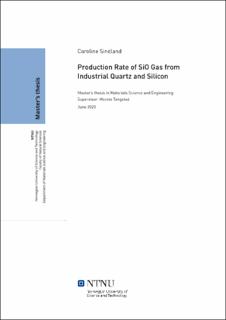| dc.contributor.advisor | Tangstad, Merete | |
| dc.contributor.author | Sindland, Caroline | |
| dc.date.accessioned | 2021-09-28T18:02:23Z | |
| dc.date.available | 2021-09-28T18:02:23Z | |
| dc.date.issued | 2020 | |
| dc.identifier | no.ntnu:inspera:59547306:15365618 | |
| dc.identifier.uri | https://hdl.handle.net/11250/2785257 | |
| dc.description.abstract | Reaksjonshastigheten til den SiO produserende reaksjonen, reaksjon mellom silisium og silika er undersøkt ved isoterm varmebehandling. Flere blandinger av silisium og silika har blitt varmet opp til temperaturer fra 1650 til 1950°C og holdt i 30 til 120 minutter før de har blitt avkjølt. Vekttapet til hver prøve har blitt knyttet opp mot reaksjonsgrad og en modell for Si + SiO2 reaksjonen har blitt utviklet basert på disse verdiene. Fem ulike typer kvarts har blitt brukt i forsøkene og det er ikke funnet noen signifikant forskjell mellom deres reaksjonshastighet, til tross for varierende smeltehastighet, hastighet for fasetransformsjon, dekrepitering og innhold av urenheter. Reaktiviteten til silisium blandet med ulike typer industriell kvarts kan derfor beskrives av en likning, gitt av likning 1. Reaksjonsgraden (α) øker med økende reaksjonsareal, temperatur og tid.
dα/dt = 9.81*10^7*A*exp(-557*10^3/RT) (1)
En bedre forståelse av SiO tap på silisiums ovner er hovedmålet for denne oppgaven. Reaksjonshastigheten for Si + SiO$_2$ reaksjonen har derfor blitt sammenliknet med reaksjonshastigheten for den andre SiO produserende reaksjonen, reaksjon mellom silika og silisium karbid. Det er vist at deres reaksjonshastighet er relativt lik, så lenge de har et relativt likt reaksjonsareal tilgjengelig og begges reaksjonshastighet øker med temperatur og tilgengelig areal. Mengden SiO gas produsert i en silisiums ovn er dermed hovedsakelig avhengig av fordeling av silisium, silika og silisium karbid i den delen av oven med høy temperatur. | |
| dc.description.abstract | The production rate of SiO gas from industrial quartz and silicon has been investigated by isothermal heat treatment experiments at elevated temperatures. Mixtures of silicon and different quartz samples has been heated to temperatures ranging from 1650 to 1950°C and held for 30 to 120 minutes before cooling. The weight loss of each sample has been correlated to degree of reaction and a model for the reaction rate of Si + SiO2 has been developed based on these values. Five different types of industrial quartz were used in the experiments and there was not found any significant difference between their reaction rate, even though there is a significant difference between the content of impurity, melting rate, decrepitation and phase transformation rate of each sample. It is therefore shown that the reaction rate of silicon mixed with various types of quartz can be described by one Arrhenius equation, given by Equation 1. A reaction constant k0 equal to 6.25*10^8 g/s*cm^2 and an activation energy (Q) equal to 557 kJ/mol were obtained by an Arrhenius plot of the experimental data. The degree of reaction (α) is increasing with an increasing available reaction area (A), temperature and time.
dα/dt = 9.81*10^7*A*exp(-557*10^3/RT) (1)
The main goal of this project is a better understanding of the overall SiO loss in silicon furnaces. The obtained reaction rate for the Si + SiO2 reaction has therefor been compared to reaction rate of the other SiO producing reaction in a silicon furnace, reaction between silicon carbide and silica. It is shown that their rate is within the same range as long as their available reaction area is within the same range, the reaction rate of both reactions increases with temperature and available reaction area. The production rate of SiO gas in a silicon furnace is therefore highly dependent on the distribution of silicon, silica and silicon carbide in the hot temperature zone of the furnace. | |
| dc.language | | |
| dc.publisher | NTNU | |
| dc.title | Production Rate of SiO Gas from Industrial Quartz and Silicon | |
| dc.type | Master thesis | |
